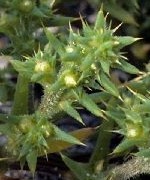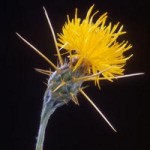|
Thursday, March 26, 2009
USDA plans to loose
biological agents against invasive thistles
Mite and weevil come to
the rescue of crops, livestock
Mateusz Perkowski
Capital
Press
Thursday, March 26,
2009
 Russian thistle with sharp prickles on the leaf margins. Russian thistle with sharp prickles on the leaf margins. |
Scientists at the USDA want
to deploy highly target-specific weapons against two common Western
weeds. The agency's Animal and Plant Health Inspection Service may
unleash biological control agents against the Russian thistle and yellow
starthistle, invasive species that afflict crop and livestock production
throughout the West. The potential effects of these biological
control efforts have been compiled by APHIS in an environmental assessment
and recently released to the public. A species of blister mite that
originates in Turkey, Uzbekistan and Greece - Aceria salsolae - has been
identified as a natural foe of the Russian thistle, which is native to
southwest Asia.
Since being introduced to South Dakota in the
1870s, Russian thistle - the tumbleweed - has spread throughout the
Western U.S., where it grows in disturbed soils and arid
regions. "The infestation of Russian thistle causes millions of
dollars of damage by disrupting automobile traffic, clogging irrigation
canals, piling up against fences and houses, and igniting and spreading
wildfires," according to APHIS.
The plant is an iconic image of the
old West, particularly when it detaches from the soil and tumbles across
the landscape. That tumbling is how the plant disperses vast numbers of
seeds over large areas, according to University of California's integrated
pest management guidelines. Aside from directly competing with
crops for moisture and nutrients, the species provides habitat for insect
pests and plant pathogens, according to the IPM
guidelines. Herbicides, grazing and tillage, among other efforts,
haven't been able to effectively suppress the weed, which is why APHIS is
looking for biological alternatives, according to the agency.
The blister mite under consideration by APHIS hides in crevices within the
Russian thistle and feeds on the plant's cell contents, resulting in the
death of its growing shoots. The mite stunts the thistle's
development and hinders its ability to reproduce, but APHIS research has
shown that it doesn't negatively affect non-target plant
species. The weevil - Ceratapion basicorne - that APHIS has
identified as a natural enemy of the yellow starthistle does minimal
damage to related non-target species, but many of them are invasive
themselves. Weevil larvae hatch on thistle leaves and burrow down
the plant's stalk and into the root crown, hindering growth and seed
production.
Yellow starthistle was brought to California in the
mid-1800s from Chile, where it was initially introduced by Spaniards in
the 17th century, according to the University of California's Weed
Research and Information Center. Since then, the weed has spread
throughout most of the U.S., but the greatest concentration is in
California, Oregon, Washington and Idaho, according to APHIS. As
with the Russian thistle, conventional weed control methods haven't been
sufficient. The weed "displaces desirable plants in both natural
and grazing areas," APHIS said. Cattle and other grazing livestock
usually avoid the plant's prickly spines, degrading the quality of
rangeland. If horses do eat yellow starthistle, toxins in the weed can
cause ulcers, brain lesions and death. "In addition to rangeland,
pastures and grasslands, yellow starthistle is the most important roadside
weed problem in much of Central and Northern California and has, on
occasion, caused problems in dryland cereals, orchards, vineyards,
cultivated crops and wastelands," according to WRIC.
|


